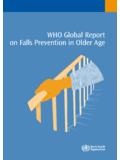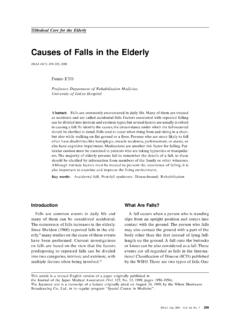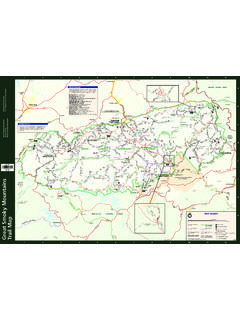Transcription of FORCES INVOLVED IN LEADER FALLS - Wallrat
1 FORCES INVOLVED IN LEADER FALLS -by Michael Strong-A LEADER fall can generate an enormous amount of energy which must be absorbed by the components of the climbing system: the climber, rope, protection points, and the belay system. Obviously, it's important that this energy does not exceed the limits of any link in the chain. It's in your best interests, therefore, to have a good understanding of how the energy of a fall is transmitted throughout the protection PHYSICS OF FALLINGD etermining the amount of energy that's produced during a fall is a study in basic physics.
2 Yes, physics. Here's your chance to apply the concepts which you learned in high school to something practical and fun. Energy of motion = 1/2 mass x velocity2 According to the above formula, the amount of energy the climbing system absorbs in a fall is equal to 1/2 the climber s weight times the square of the climber's speed at the moment the rope begins to stop the fall . In practical terms, this means the falling climber accelerates, falling faster each second. The longer the fall , the greater the acceleration, and the greater the energy that must be absorbed!
3 The energy of a fall is dispersed largely (but not totally) by the climbing rope. As a result, a great deal of energy (human energy, that is) has been spent estimating the damage done to the rope during FALLS of different lengths. Enter the fall factor. A. The fall FactorThe fall factor is a rating of the seriousness of a fall . It provides an estimation of the damage to your rope when you fall on it. It's expressed as a ratio between the length of the fall and the length of rope available to absorb the Factor = length of the falllength of available rope For example, if you climb 10 above the belay and fall before placing a piece of protection, you'll fall 20' on 10' of rope before the force of the fall is contained at the belay (assuming the belayer doesn't let the rope slip through the belay device and that you can fall freely past the belayer).
4 This is a factor-2 fall , the highest possible. You experience the greatest impact force possible in this Factor = 20' fall = ' of rope Figure 1 illustrates a factor-2 is locked off at the belay device10'Figure 1A Factor-2 FallThe climber FALLS when 5' above the piece. With 10' of rope payed out by the belayer, the length of the fall is 10', a factor-1 'Figure 2A Factor-1 Fall5'10'This time, let s say that you place a piece of protection 5' above your belay, climb 5' higher, and then fall , as shown in Figure 2.
5 The fall factor in this situation is 1, providing that the belay is static ( the rope does not slip through the belay device). B. Impact ForceThe force felt by the climber when the fall is stopped is called the impact force . Impact force is determined by the length of time over which the fall is stopped. The shorter the time, the higher the impact force , and vice versa. Imagine taking the factor-2 fall illustrated in Figure 1 on a steel cable. Since the cable doesn't stretch, the energy of the fall is transferred to you in an instant, likely with enough impact force to break your back!
6 A fall on a climbing rope is stopped over a longer period of time, with the rope absorbing much of the energy of the fall , keeping impact force within acceptable a longer fall produce more energy? Yes, because the climber continues to accelerate until the fall is stopped. Does a longer fall produce a greater impact force ? Not necessarily! Interestingly enough an 8' fall on 4' of rope produces the same fall factor (hence impact force ) as a 60' fall on 30' of rope. The energy of the longer fall is absorbed by the proportionally longer section of rope.
7 Does this mean that the longer fall is just as safe as the shorter one? No, for you'll fall faster during the longer fall . The consequences of impact with a ledge or outcropping are likely to be far more serious. Also, at the end of a longer fall , force is exerted on the protection system and your belayer over a longer period of time, increasing the possibility for failure of your protection system, and slippage of the rope through the belay device (not necessarily a bad occurrence as we'll see later). C. The Effects of FrictionThe factor-1 fall illustrated in Figure 2 above is relatively frictionless ( the rope passes through only one carabiner).
8 As you progress upwards and place more pieces, friction develops in the system as the rope passes through multiple carabiners. The upshot of this friction? No longer does the entire length of rope between you and the belayer experience the same force during in a fall . The section of rope between you and your last piece takes a disproportionate share of the load during a fall , and the fall factor is increased even more!What can we learn from the concepts of fall factor, impact force and friction?1. Avoid a factor-2 fall at all costs.
9 Without friction in the system you'll experience a tremendous amount of force . So will your belayer when the fall comes onto a belay device in the seat harness, or the anchor, if the belay is from the anchor. 2. Reduce the fall factor by placing protection early and often at the beginning of a lead. If the climb does not protect right away, consider using the anchor as your first piece. Should you fall before getting a piece in, the fall will be a little shorter. In addition, the friction of the rope passing through the anchor protection reduces the force on your Keep your protection system as free from friction as possible.
10 Reduce rope drag by using runners to keep the rope from zig zagging between protection points. Make sure that the rope does not get wedged in a crack or pulled forcefully into the rock during a fall ( against the lip of a roof or onto the edge of a corner), for if you fall when this happens, the length of rope below this point is unavailable to absorb the energy of your fall . You and the top piece of protection will experience a tremendous force , perhaps enough force to cause the piece to pull, or even enough force to severely abrade, or cut your rope!





